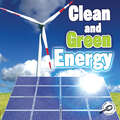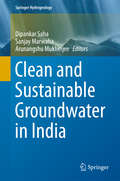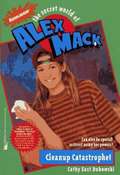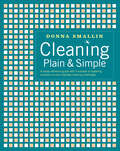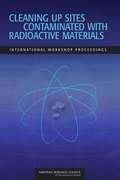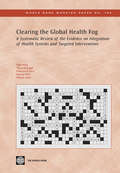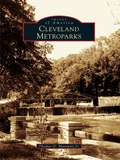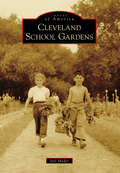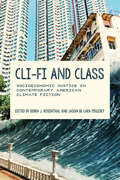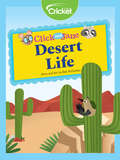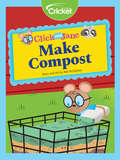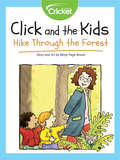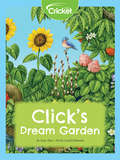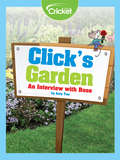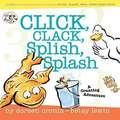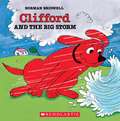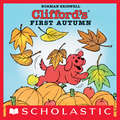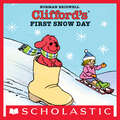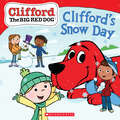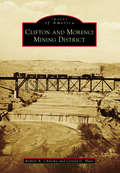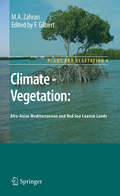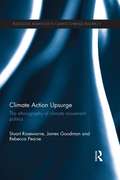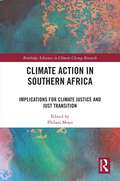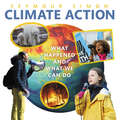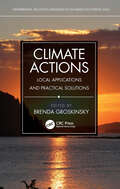- Table View
- List View
Clean and Green Energy (Green Earth Science Discovery Library)
by Colleen HordYoung Readers Will Discover What Types Of Energy Are Clean And Have Less Impact On The Environment.
Clean and Sustainable Groundwater in India (Springer Hydrogeology)
by Dipankar Saha Sanjay Marwaha Arunangshu MukherjeeThe book embodies the groundwater issues and challenges in India focusing its sustainable use. It is a compilation of papers presented by the eminent experts from Government departments, academia, research institutes, NGOs and stakeholders who assembled at Kurukshetra on 21st August, 2015 in the event of Bhujal Manthan or "Churning of Groundwater" organized for the first time by Ministry of Water Resources, River Development and Ganga Rejuvenation, the apex Ministry of Water Resource under Government of India. India, as a country, is the highest groundwater extractor in the world. Its service towards attaining the food and clean drinking water security is well documented. This volume addresses the issues of aquifer characterization, groundwater contamination, groundwater resource availability and its sustainable management through community participation in pan-India scenario. This book provides a unique opportunity for its readers to understand groundwater domain in India in its entire gamut. The papers included in the volume were selected carefully from the presentations made in the following four broad topics during the Manthan; (i) groundwater quality, (ii) conjunctive use of surface and groundwater, (iii) management intervention and sustainable use of this resource, and (iv) groundwater problems and application of various techniques. The book contains 20 papers including an introductory chapter by the editors. The content of the book is enriched by contributions from eminent researchers and activists in groundwater domain, like Prof. Tushar Shah, Prof. Himanshu Kulkarni, Dr. D. K. Chadha, Dr. Bharat Sharma and others. The recommendations in the individual papers are of immense significance for keeping the groundwater of the country clean and sustainable. The volume will help the readers to understand the groundwater issues of the country and also assist policy makers to prepare strategies for its better governance and management with environmentally sustainable ways.
Clean-up Catastrophe! (The Secret World of Alex Mack #6)
by Cathy East DubowskiIt's Alex's chance to organize her schoolmates to do a community cleanup project, win the prize and show everybody how special she is. She is so hard on her friends that they go to the competitor. Now she has to use her powers.
Cleaning Plain & Simple: A Ready Reference Guide with Hundreds of Sparkling Solutions to Your Everyday Cleaning Challenges
by Donna SmallinLearn how to clean smarter, not harder, and you&’ll have more time to do the things you love. With plain and simple advice on everything from dusting and swabbing to polishing and vacuuming, best-selling author Donna Smallin shows you how to make the most of your valuable cleaning time. Hundreds of quick tips and practical solutions for every imaginable cleaning situation promise you the sparkling, healthy environment you want for your family. This publication conforms to the EPUB Accessibility specification at WCAG 2.0 Level AA.
Cleaning Up Sites Contaminated With Radioactive Materials: International Workshop Proceedings
by National Research Council of the National AcademiesThis publication features papers presented at the Workshop on Cleaning Up Sites Contaminated with Radioactive Materials, held in Moscow in June 2007. This activity was organized by the National Academies in cooperation with the Russian Academy of Sciences and with funding provided by the Russell Family Foundation. The workshop was designed to promote exchanges of information on specific contaminated sites in Russia and elsewhere and to stimulate greater attention to the severity of the problems and the urgent need to clean up sites of concern to the local and international communities.
Clearing the Global Health Fog
by Olusoji Adeyi Thyra De Jongh Kelechi Ohiri Federica V. Secca Rifat AtunA longstanding debate on health system organization relates to the benefits of integrating programs that emphasize specific interventions into mainstream health systems to increase access and improve health outcomes. This debate has long been characterized by polarization of views and ideologies, with protagonists for and against integration arguing relative merits of each approach. Recently, the debate has been rekindled due to substantial rises in externally-funded programs for priority health, nutrition, and population (HNP) interventions and an increase in international efforts aimed at health system strengthening. However, all too frequently these arguments have not been based on hard evidence. In this book we present findings of a systematic review that explores a broad range of evidence on: (i) the extent and nature of integration of targeted health programs that emphasize specific interventions into critical health systems functions; (ii) how the integration or non-integration of health programs into critical health systems functions in different contexts have influenced program success; and (iii) how contextual factors have affected the extent to which these programs were integrated into critical health systems functions. The findings provide a new synthesis of evidence to inform the debate on health systems and targeted interventions. In practice a rich mix of solutions exists. While the discussion on the relative merits of integrating health interventions will no doubt continue, discussions should move away from the highly-reductionist approach that has polarized this debate.
Cleveland Metroparks
by Thomas G. Matowitz Jr.A century ago, William A. Stinchcomb, aged 27, closed his annual report as chief engineer of parks for the City of Cleveland with a challenge to create an outer ring of parks and boulevards to benefit all residents of Greater Cleveland. By 1912, legislation authorizing it had been enacted, and three acres of land were acquired through a donation. This formed the nucleus of the vast park system that now includes almost 21,000 acres. Cleveland Metroparks has provided generations of area residents with readily accessible facilities for year-round recreation. The park provides opportunities for hiking, horseback riding, swimming, cycling, golfing, and boating. Use of the park, which crosses the boundaries of approximately 48 communities in the Cleveland area, has become a tradition for many families.
Cleveland School Gardens (Images of America)
by Joel MaderThe Cleveland Public School's tract garden program was one of the most successful and innovative programs of the school system. The organization and beauty of the gardens attracted horticulture educators from all over the United States, South America, and as far away as Japan. From its humble beginnings in 1904 as a project to beautify vacant lots in Cleveland, it grew into an educational tool that taught thousands of children the respect for nature and its bounty. At the tract gardens' height, the amount of land under cultivation in the middle of the Cleveland urban landscape approached 100 acres. By 1970, there were 27 horticultural centers servicing all Cleveland schools. Centers were located next to schools, in housing estates, at fairgrounds, at a home for the aged, and on museum property. A few of the centers are now neighborhood gardens. The photographs in Cleveland School Gardens show that the Cleveland Public Schools knew the importance of being "green" 100 years before it was politically fashionable.
Cli-Fi and Class: Socioeconomic Justice in Contemporary American Climate Fiction (Under the Sign of Nature)
by Adam Trexler Matthew Schneider-Mayerson Magdalena Maczynska Andrew Milner Lisa Ottum Martín Premoli B. Jamieson Stanley Jessica Cory Jennifer Horwitz Professor Jennifer Schell Kimberly Bain Jeffrey M. Brown Teresa GodduSince its emergence in the late twentieth century, climate fiction—or cli-fi—has concerned itself as much with economic injustice and popular revolt as with rising seas and soaring temperatures. Indeed, with its insistent focus on redressing social disparities, cli-fi might reasonably be classified as a form of protest literature. As environmental crises escalate and inequality intensifies, literary writers and scholars alike have increasingly scrutinized the dual exploitations of the earth&’s ecosystems and the socioeconomically disadvantaged. Cli-Fi and Class focuses on the representation of class dynamics in climate-change narratives. With fifteen essays on the intersection of the economic and the ecological—addressing works ranging from the novels of Joseph Conrad, Cormac McCarthy, and Octavia Butler to the film Black Panther and the Broadway musical Hadestown —this collection unpacks the complex ways economic exploitation impacts planetary well-being, and the ways climatic change shapes those inequities in turn.
Click and Jane: Desert Life
by Rob McClurkanWhat animals do you think live in the desert? Follow Click and Jane as they travel through the desert. Not believing anything can live in the hot, dry desert, Click quickly learns that plenty of creatures make their homes in the desert. As the pair is introduced to different birds, plants, reptiles, coyotes, and owls, Click and Jane are able to come to appreciate the desert. The two continue their journey as they help the desert animals plan a pool party—the only problem is that the pool doesn’t have any water!
Click and Jane: Make Compost
by Rob McClurkanMaking a compost pile is a simple way to dispose of waste—like leaves, grass clippings, fruit, and vegetable peels—and turns them into healthy food for plants! Cece notices how nice Jane’s flowers are and wants to make a compost pile, too! Jane and Click show their friends how to make compost and you can learn too! What else is needed to help the compost decompose?
Click and the Kids: Hike Through the Forest
by Betsy Page BrownMartin, Liz, and their friend take a hike through the forest and learn about animals and plant life. This forest ecosystem is a healthy environment for animals and plant life to grow. A woodpecker checks for bugs to eat in a nearby tree, with bark that is ancient. Martin notices moss on the old tree bark and poisonous mushrooms! What else will they find on their forest hike?
Click's Dream Flower Garden
by Carol Schwartz Amy TaoClick loves flowers! If he could have anything he wanted in his garden, he would choose flowers with a variety of different seeds, bulbs, leaves, and stems so he could enjoy all sorts of pretty colors and interesting plants! Did you know that orange blossoms turn into fruit, or that a pussy willow’s flowers are called a catkin? Follow along with Click and learn all sorts of cool flower stuff!
Click's Garden: An Interview with Rose
by Amy TaoClick the mouse learns all about plants from his garden flower, Rose.
Click, Clack, Splish, Splash: A Counting Adventure (A Click Clack Book)
by Doreen Cronin Betsy Lewin<p>Duck is about to trick poor Farmer Brown once again. While the farmer is sleeping the afternoon away, Duck and the other animals are planning a most unusual fishing trip. Sneaking past Farmer Brown is going to be as easy as 1, 2, 3! <p>This numerical adventure for the very youngest Duck fans brings counting books to a whole new level -- click, clack, splish, splash!</p>
Clifford And The Big Storm
by Norman BridwellThe most popular big, red, lovable dog that ever was! Clifford books have sold millions of copies in nearly half a century - and his series airing on PBS Kids TV has been enormously popular. In this book, When a hurricane strikes while Clifford and Emily Elizabeth are having fun visiting her grandmother at the beach, Clifford the big red dog knows just what to do to keep everyone safe.
Clifford's First Autumn (Clifford Ser.)
by Norman BridwellClifford learns about autumn.Summer is over, and Clifford the small red puppy, is curious about the changes that are happening all around him.
Clifford's First Snow Day (Clifford the Big Red Dog)
by Norman BridwellIt’s been snowing all night—and that means a day of fun for Emily Elizabeth and her adventurous red dog!Emily Elizabeth remembers when Clifford was a little puppy and discovered winter weather. The snow was so deep it was almost over his head. Good thing he had a fur coat to help keep him warm while he slid down the hill! With this fun-filled picture book in the wildly popular series, toddlers and early readers can join Clifford as he experiences the joys of seeing, and playing in, snow for the first time.
Clifford's Snow Day (Clifford the Big Red Dog Storybook)
by Reika ChanEnjoy a snow day with Clifford the Big Red Dog!It's a winter wonderland on Birdwell Island! After a big snowstorm, Clifford and Emily Elizabeth get their first snow day. The best friends have a blast playing Snow Rescue Squad and helping Fire Chief Franklin take care of snow duties across town.But Clifford catches a cold from his busy day outside! The big red dog can't stop sneezing and sniffling. Can his friends on Birdwell Island help him feel better?Featuring adorable art from the new TV show!
Clifton and Morenci Mining District
by Robert A. Chilicky Gerald D. HuntAcross America, from big cities to small towns and rural hamlets, there are many stories of challenges, historic events, courageous people, tragedy, and success. Some of the best and most exciting tales may not be well known. Such is the case for the towns of Clifton and Morenci, Arizona. They survived labor strikes, rising and falling copper prices, devastating floods, outlaws and lawlessness, gambling houses, and saloons. All this added to the lore that these towns were some of the roughest communities in the West. Today, after 143 years of mining, Freeport-McMoRan's Morenci copper mine is the largest in North America. Expansion has required new homes in Clifton-Morenci, a modern library, and recreational facilities. Residents are proud of their communities.
Climate - Vegetation: Afro-Asian Mediterranean and Red Sea Coastal Lands (Plant and Vegetation #4)
by M. A. Zahran Francis GilbertDeserts are unique ecosystems with their own biotic and abiotic components, and are often rich in renewable natural resources, the appropriate management of which can contribute significantly to the sustainable management of desert regions for the welfare of the people. Yet while there are many books on the flora of the countries fringing the important desert countries of the Mediterranean and Red Seas, there or few books reporting on their ecophysiology and vegetation ecology. This book presents the vegetation types of the African and Asian countries of the Mediterranean and Red Sea coastal regions, and discusses the ecological threats and economic applications of these critical resources. In particular, it examines the relationships between climate and vegetation, and discusses these within the context of desertification, agro-industrial applications, ecotourism and sustainable development. The book will provide a valuable reference for researchers and graduate students involved in plant ecology, biogeography, economic botany and environmental management in the Afro-Asian Mediterranean and Red Sea coastal regions, as well as other desert regions around the world.
Climate Action Upsurge: The Ethnography of Climate Movement Politics (Routledge Advances in Climate Change Research)
by James Goodman Rebecca Pearse Stuart RosewarneIn the late 2000s climate action became a defining feature of the international political agenda. Evidence of global warming and accelerating greenhouse gas emissions created a new sense of urgency and, despite consensus on the need for action, the growing failure of international climate policy engendered new political space for social movements. By 2007 a ‘climate justice’ movement was surfacing and developing a strong critique of existing official climate policies and engaging in new forms of direct action to assert the need for reduced extraction and burning of fossil fuels. Climate Action Upsurge offers an insight into this important period in climate movement politics, drawing on the perspectives of activists who were directly engaged in the mobilisation process. Through the interpretation of these perspectives the book illustrates important lessons for the climate movement today. In developing its examination of the climate action upsurge, the book focuses on individual activists involved in direct action ‘Climate Camps’ in Australia, while drawing comparisons and highlighting links with climate campaigns in other locales. The book should be of interest to scholars and researchers in climate change, environmental sociology, politics, policy and activism.
Climate Action in Southern Africa: Implications for Climate Justice and Just Transition (Routledge Advances in Climate Change Research)
by Philani MoyoUsing climate justice as an analytical tool, this volume examines the role of local mitigation and adaptation actions in Southern African in furthering climate resilient development. Climate Action in Southern Africa examines the intrinsic connection between local climate actions, climate resilient development and strides towards a just transition. The theoretical grounding in climate justice allows the authors to analyze whether current climate actions in Africa are truly effective for the poor and marginalized whose lives and livelihoods are impacted by a climate crisis largely not of their making. The authors also question the extent to which pathways to net zero carbon emissions by 2050 are achievable in Africa and ask whether this can be attained without undermining livelihoods and human development. Overall, the book argues that for any transition to be a just transition it has to be aligned with the pursuit of sustainable development and climate justice for current and future generations on the African continent. Drawing out key factors including politics, gender and migration, this volume will be of great interest to students and scholars of climate change, climate justice and African development.
Climate Action: What Happened and What We Can Do
by Seymour SimonMeet the young activists who are using their voices and minds to fight climate change. Did you know that the past five years have been the hottest ever recorded? Or that over seven million people participated in the global Climate Strike? We’re facing a very real problem, but there’s hope. Everyone is affected by climate change. Reading Climate Action: What Happened and What We Can Do is the perfect introduction not only to the dramatic effects of climate change, but to the solutions. Learn how our behavior and actions have led us to this point, hear from kids around the world dealing with extreme storms, wildfires, and sea level rise, and discover what scientists, youth activists, and ordinary citizens are doing to protect their communities. Divided into eight sections for easy browsing and with over fifty photographs, captions, charts, and graphs, this nonfiction book is an excellent choice to share in the classroom and for homeschooling for kids ages 6 and up. Also includes a glossary to supplement the text, author’s note, and index. Climate Action is the latest of Seymour Simon’s nonfiction science books. His books are regularly honored by the National Science Teacher's Association.
Climate Actions: Local Applications and Practical Solutions (Environmental and Societal Dimensions of Sustainable Development Goals)
by Brenda GroskinskyThis book offers a diverse set of solid concerted strategies in the development and implementation of specific "climate actions," in natural and built places where we all live. The book also serves as a conduit of knowledge for those who are unsure on how they can make a difference for their families, their communities, and the natural places that surround them. Through many actionable examples of mitigation efforts for the ever-present effects of climate change, especially for those who may not understand the wide range of climate action opportunities that are available. Scientists, academics, and community leaders, will find concrete examples on how they too, can develop and implement climate action solutions.
